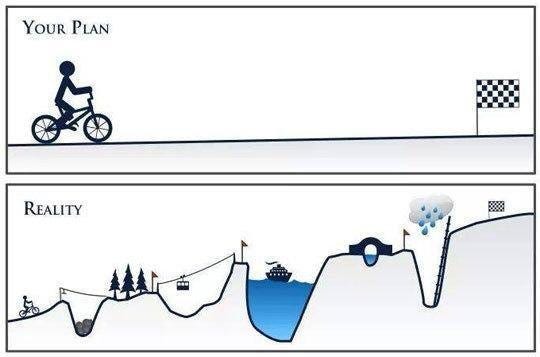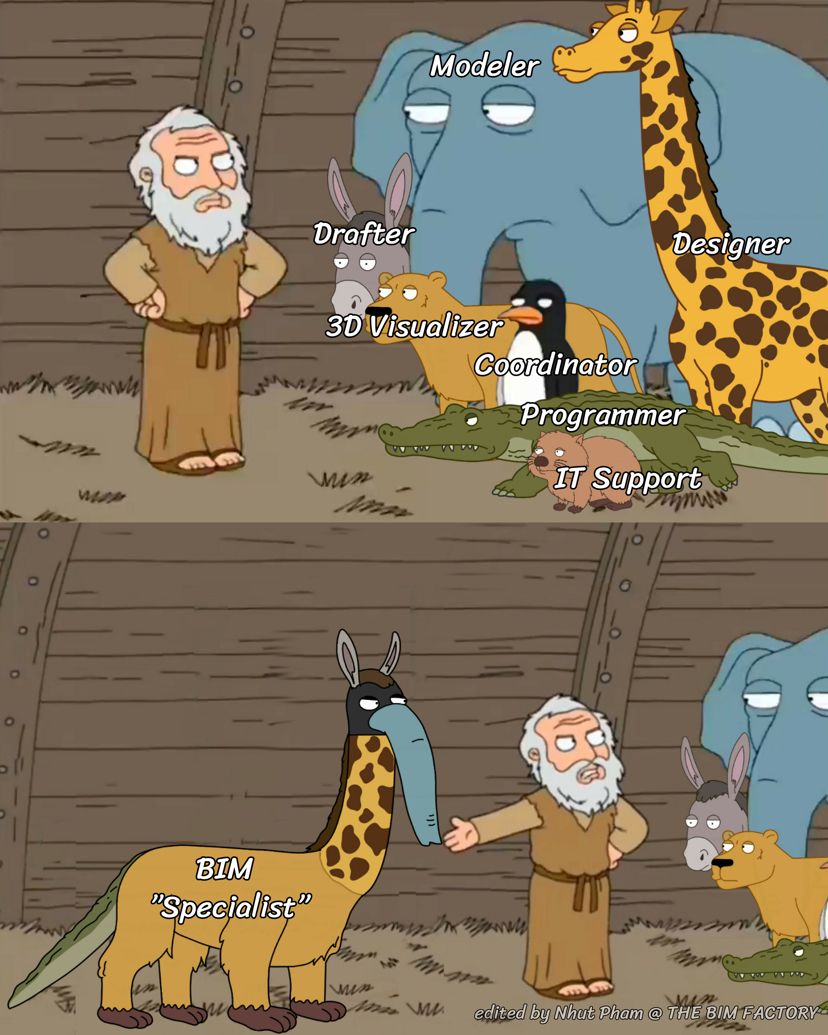Introduction
I'm increasingly seeing that software developers in the BIM industry are facing a serious issue, that is burnout. This not only affects their mental health but also impacts their work performance. In this article, I'll delve deep and examine this issue from various perspectives.
There are many people in the industry who texted myself, and I definitely have to help them speak out about this issue. I felt that if I didn't say it, the people who texted me did not know how long they could really endure.
BIM & Software Development
Indeed, software development in the field of BIM is not an easy task. It requires a deep understanding of the construction and architecture industry, as well as a solid knowledge of programming. This poses a significant challenge for software developers, especially for those who are just starting out.
Even experienced software developers face many difficulties in the process of developing software for the BIM industry. They need to grasp the basic concepts of BIM, understand the workflows of BIM professionals, and at the same time, know how to interact with popular BIM software such as Revit, AutoCAD, and Navisworks.
And even for the most skilled software developers in the AEC industry with a solid foundation in construction, they cannot avoid issues of burnout. First, they dedicate a large portion of their time to learning additional software development skills, and then they must apply that knowledge in practice as a software developer in the BIM industry. This also means that the expectations placed on them are not insignificant in either field.
Causes of Burnout
There are several reasons leading to burnout in the BIM software development industry. Here are some common causes:
- Misunderstanding by Management: Managers often lack a clear understanding of software developers' work. This leads to inaccurate estimates of the time and effort required to complete a software project. In reality, relying solely on experience from one field to make predictions for a field one doesn't fully understand can lead to serious errors. If you're lucky to find a manager with good experience in BIM software development, hold onto them tightly. I can make sure that very hard to apply the way management for BIM project to software development project.

High Expectations from BIM Engineers and Construction Experts: Sometimes the expectations from BIM engineers and construction industry experts can be overwhelming. They often have very specific requirements for the software they want, and sometimes those requirements are not always feasible. This places significant pressure on software developers, especially when they have to deal with unrealistic, vague, or even impossible requests. Some time the problem look so easy to solve, but when you start and try to solve it, you will find that it is a very complex problem under technical limitations.
Priority on Delivering Results over Good Code Design: This means you have to write code quickly and efficiently, rather than focusing on writing well-structured, readable, and easily expandable code from the outset. This can lead to writing non-optimal, hard-to-maintain, and error-prone code. In the short term, writing code quickly may help you meet project deadlines and solve immediate issues, but in the long run, it can lead to serious maintenance and code expansion problems. The lack of clarity in software design and gaps in the process contribute to long-term burnout in the job.

Overwhelming Responsibility for a Software Project: Sometimes you have to act as if you were a small business, doing Frontend, Backend, DevOps, QA-QC, Marketing, and more. This leads to facing multiple issues simultaneously, and sometimes you can't focus on a specific task. This can lead to burnout and loss of focus at work. In software development companies, it's a whole department, a large team developing software, but in the AEC industry, you may have to deal with all those issues alone.
Lack of Support from Colleagues or Management: This can lead to feelings of isolation and undervaluation, increasing the risk of burnout. Documents are no longer updated, and there's no one to ask. You have to fend for yourself and find solutions to every problem alone or seek help from the online community. It's a exhausting process and sometimes there's no way out. Remember that you are working in environment that is not a software development company, so you have to deal with it.
Poor or Uncertain Estimates: Another cause of burnout is poor or uncertain estimates. This can lead to you having to work more hours than planned or having to work on weekends to complete the project.

- Mixed Skill Levels: In the BIM industry, software developers often work with a mix of skill levels. This can lead to misunderstandings, miscommunication, and conflicts between team members. It can also lead to a lack of trust in the team and a lack of confidence in the software product being developed. Some people want work as a developer, software engineer, and also as a BIM engineer, Architect, or BIM Coordinator, that is a lot of work for one person without commit or ensure the quality of the software product.

Note
I've seen many developers leave software products in BIM companies due to debt. Here, debt doesn't refer to financial debt, but rather a debt of knowledge and skills, especially technical debt. They can't keep up with the rapid development of the software industry and can't deliver high-quality software products as desired in the BIM industry. This means they have to spend more and more time paying off this debt before they can continue developing new software.
- Long-standing Software: The engineers use many old software may have been around for a very long time, meaning they're dealing with many outdated technologies and processes that are no longer suitable for the current era. This consumes a lot of time and effort for software developers to understand these outdated technologies and find the best solution for the problem. Let's imagine you have to work with a software that was developed in 2000, and you have to maintain it, update it, and add new features to it. It's a nightmare for software developers.

AI & Automation
The hype around AI is growing rapidly, and it's gradually making its way into all aspects of life. And I believe the BIM industry still has a long way to go to apply AI to its work. This means that queries under the support of AI currently will retain many errors due to inconsistent, inaccurate, and low-quality documents and information. It will lead to an increasing illusion and exacerbate burnout for software developers in the BIM industry. Before the ChatGPT wave happened, I was happy reading source code from forums, but now I can't finish reading it anymore. I have to spend five times the time to verify, understand, and check the source code.

AI tools contribute to enhancing the strength of new engineers but also present a double-edged sword for beginners. It helps them quickly get into work but also creates a dependence on technology that they cannot control. This leads to the inability to solve problems on their own and instead rely on technology to solve them. A vicious cycle will pursue them for a very long time until they truly realize it.
AI tools for experienced individuals help foster creativity and enhance productivity. This helps them save time and effort in solving complex problems. However, it is also making many software developers lazy in thinking and no longer seeking the best solution to the problem, but rather relying on AI tools to solve it. This leads to a lack of creativity and innovation in the software development process.
Value of Software Development in BIM
Despite being a challenging endeavor, software development in BIM holds value that may not yield immediate results but takes many years to manifest. Some software development companies in the BIM industry fail to grasp the true value of the software they develop. This ultimately results in a lack of proper appreciation from both the software development team and the end users. Consequently, software development fails to bring real value to end users and the construction industry as a whole, creating a sense of frustration for both software developers and businesses utilizing the software.
While software development shortens the working time for BIM engineers, it also means that software engineers face significant challenges in solving complex issues in the construction industry. However, their contributions are often undervalued and unrecognized.
Note
I've witnessed many software developers leaving the BIM industry because they don't see the value in their work nor receive the recognition and encouragement they deserve. Additionally, they often don't receive high praise from end users. It's regrettable because we're gradually losing skilled software developers and knowledgeable individuals in the BIM industry.
Coping with Burnout
I'm not sure if I've fully addressed burnout in BIM software development on my own. However, here are some ways I've tried to help myself overcome burnout:
Take a Break from Work: This could be a day off or a short vacation. The important thing is to temporarily step away from work to rest and recharge. Try practicing yoga, meditation, or engaging in other extracurricular activities to help reduce stress and boost mental health.
Speak Up About Your Challenges: Sometimes, sharing with others about the challenges you're facing can help alleviate pressure and create a sense of comfort. Find a trusted friend or a support group to share your thoughts and feelings with. In the world of software development, staying silent doesn't mean you're solving the problem; speak up to others and share with those who have more experience.
Recently, I've also gradually distanced myself from open-source projects for my mental health. I'm not as involved in open-source projects as before but focus on developing software products for the company and personal software products. This also helps me feel lighter in software development. Note that I've been an open-source enthusiast for a long time.
Conclusion
I've certainly experienced burnout as a regular software developer in the BIM industry. It's unfortunate, but it's also an inevitable part of the AEC software development process. However, it's crucial to recognize and address this issue positively.
I'm not sure how long I'll maintain my energy in the BIM software industry, but I'm certain that software development in the BIM industry is fascinating and not an easy job. It requires perseverance, resilience, and continuous creativity to produce high-quality software products. I hope that what I've shared in this article will be helpful to those facing burnout issues in the BIM software development industry.
If someone asks me whether they should pursue a career in software development in the BIM industry or not, I would say it's a personal decision. If you're passionate about the work, go for it. But if you're only in it for the money, consider switching directions or fields because it's difficult to sustain it in the long run, sooner or later.